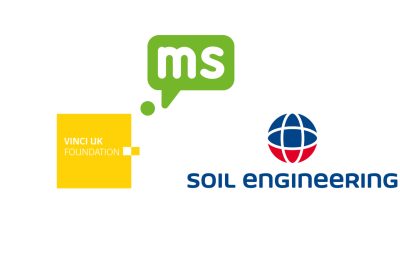

To provide data on the ground and groundwater conditions at the site of a proposed rail bridge replacement on the A8, Amey engaged Soil Engineering to undertake a ground investigation within the carriageway of this busy arterial route. Completed in three phases of traffic management to minimise the extent of lane closures, the pairs of boreholes allowed an assessment of mining risk beneath the site, whilst also recovering samples for environmental analysis.
Key to the successful design of the replacement bridge was the correct identification of the coal seam underlying the site, and understanding its condition. Seven cable percussive boreholes were formed through superficial deposits and highly weathered rock to provide detail for shallow foundations. Six of these holes were then extended by rotary drilling in order to provide data on the competent rock, and critically on the location and condition of a coal seam mapped as underlying the site.
As the boreholes were located away from buried structures and properties, they were advanced using air-mist flush, in accordance with the Coal Authority Permit. Gas monitoring was undertaken throughout drilling and subsequent installation of monitoring equipment to ensure no elevated levels of harmful or flammable gases were encountered. A completion report was issued to the Coal Authority when borehole records were finalised.
Following the intrusive phase of the ground investigation, several rounds of monitoring were undertaken to determine gas values in the ground, and to recover samples for environmental testing. These, and samples taken from the Cable Percussive boreholes, were shipped to a specialist laboratory. Results of the tests will inform key aspects of buildability, including potential soil disposal costs and material constraints. Each samples was tested using a PID meter prior to shipping, giving a rapid indication of the presence of any hydrocarbons, a potential key contaminant in the highway environment.

As 2025 draws to a close, and our business travels wind down, we’re reflecting on some of the journeys made throughout the company this yearJourneys to the depths… Our rotary coring crews have been plumbing new depths, with a company record set on Merseyside when a cored borehole reached just over 300m, recovering 105mm core […]
Read more ➜
Double success at Soil Engineering this week as two areas of the business were recognised with the global Green Is Great label by Soletanche FreyssinetMarking best practice across our global operations the Green is Great programme recognises the efforts and innovations of the global efforts of our people, projects and depots. Simultaneously achieving gold standard […]
Read more ➜
Amongst the £238,000 in grants provided in 2025 by our group charitable wing, the VINCI UK Foundation, is a successful application championed by Soil Engineering Geoservices. At the heart of the VINCI Group’s ethos is a commitment to improving everyday life and mobility for all. This dedication goes beyond the infrastructure and facilities we design, […]
Read more ➜